Abstract
In the Chinese city of Wuchang, Heilongjiang Province, a survey was conducted to track the concentrations and distributions of several organic pollutants near drinking water reservoirs, such as conventional organochlorine pesticides (OCPs) and currently in use pesticides (CUPs), including organophosphorus pesticides (OPPs) and neutral herbicides (NHs). From October 2007 to July 2008, a total of 32 pairs of water and sediment samples were gathered and examined. The results showed that the total concentrations of OCPs, OPPs, and NHs in the sediments were 0.42–7.8 ng/dm3 below the detection limit of these pollutants in sediments. The total concentration of OPPs in the water varied from the LoD to 180 ng/dm3 while NHs were 6.3 to 740 ng/dm3. While the CUP concentrations changed significantly throughout the year, the OCP concentrations were less impacted by seasonal fluctuations, indicating no recent introduction of these chemicals. The use of pesticides on crops in the primarily agricultural area was the main factor contributing to higher concentrations of CUPs during the summer.
1. Introduction
Polycyclic aromatic hydrocarbons (PAHs), neutral herbicides (NHs), organochlorine pesticides (OCPs), organophosphorus pesticides (OPPs), and other semivolatile organic contaminants (SOCs) are pervasive in the environment. Agriculture has long utilized pesticides. OCPs such as DDT (including derivatives DDE and DDD), HCH (containing α-, β-, and γ-HCH isomers), and others can still be found in water, sediment, and soil even though most of them have been banned for more than 30 years [1,2,3,4]. The widespread usage of CUPs was encouraged by the restriction on OCPs. Some CUPs were nevertheless toxic to the environment despite having a decreased toxicity [5,6]. For instance, it has been determined that pyrethroid is a significant cause of toxicity in aquatic creatures [7]. The expectation that a new generation of non-persistent pesticides OPPs was easily biodegradable was dashed, however, when Macdonald announced that some of the OPPs had been found in the area of the Arctic in 2000 [3,8,9]. These pesticides’ presence in the Arctic suggests that they are widely consumed and have a long atmospheric half-life [8,10]. Dimethoate, for instance, has a half-life of 24 days in orange juice at 40 °C, but when the temperature decreases to 15 °C or 0 °C, it grows to 533 days or 1733 days, respectively [11]. CUPs such as atrazine and dichlorvos have been found in drinking water, agriculture, marine life, and the area around the Arctic [9,10,12]. The ecology in China has been significantly destroyed by the country’s fast-growing industry, agricultural operations, municipal growth, and rising chemical use. The northeastern Chinese city of Wuchang was chosen for the study because it is a significant grain-growing zone (a flat area with very fertile soil for agriculture) and a significant source of drinking water for adjacent cities. However, the effects of SOCs on drinking water supplies in the ecosystem have not been explored yet. This study aimed to investigate the distribution, origins, and pathways of OCPs and CUPs used in agriculture in drinking water resources and the surrounding areas.
2. Material and Methods
2.1. Study Area and Sample Collection
Figure 1 shows the study area and Table 1 shows the specifics of the sampling locations. Each sampling location is within 120 km of Mopanshan Reservoir. Wuchang City is a part of Heilongjiang Province in Northeastern China. A chilly monsoon typically characterizes the area, with an average annual temperature of 3.5 °C. The Lalin and Mangniu rivers both travel through the Wuchang region and are among its many abundant water resources. The Mopanshan Reservoir situated in the Lalin river is a significant drinking water source for Harbin city, the capital of Heilongjiang Province. The Longfengshan Reservoir is situated on the upper levels of the Mangniu River. The dam site for Mopanshan Reservoir, which has the highest level of any reservoir on the Lalin River’s main stream, is situated upstream from the Lalin River in Shenjiaying Village, Shahezi Town, Wuchang City, Heilongjiang Province. It is 8 km away, 343 km from the river’s mouth, and the dam’s location is around 180 km from Harbin’s downtown. The reservoir’s geographic coordinates are E127°41′20″, N44°23′40″. During the winter season’s low water period (LWP) in December 2007 and the summer season’s high water period (HWP) in September 2008, a total of 32 pairs of samples were taken, including 32 water samples and 32 sediment samples (Figure 1). In Figure 1, sixteen sampling locations are depicted. Using 4.5 dm3 glass jars, water samples were taken from 0.5 m below the water’s surface. Using a grab sampler, sediment samples were taken. Near the silt, soil samples were gathered. The sampling stations were located using a global positioning system (GPS) during the entire sampling operation. After collection, all samples were immediately brought to the lab and kept there for two days at 4 °C before being extracted.
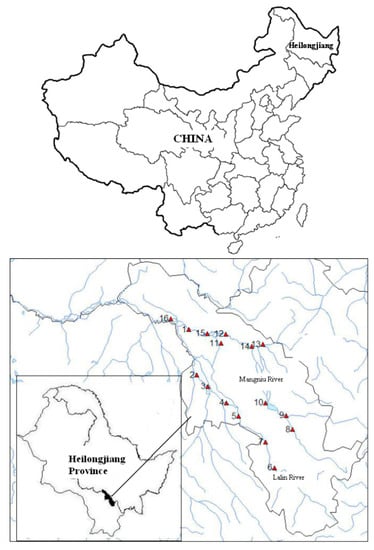
Figure 1.
Northeastern China’s map reveals 16 sample locations close to a drinking water reservoir.

Table 1.
The location of sampling site.
2.2. Chemical
The solvents, acetone, hexane, and dichloromethane (DCM) of HPLC grade, were purchased from J. T. Baker USA. Anhydrous sodium sulfate (Na2SO4, Tianjin Chengguang chemic reagent Co., Tianjin, China) was cleaned at 600 °C for 6 h, and silica gel (100–200 mesh, Merck Co., Darmsdadt, Germany) was activated at 120 °C for 16 h before being stored in a desiccator until use.
The mixed standards of 41 CUPs (Butylate, Ethalfluralin, Trifluralin, Demeton-o, Diallate, Atrazine desmethyl, Atrazina desisopropyl, Demeton-s, Diazinon, Atrazine, Simazine, Triallate, Disulfoton, Carbofuran, Dimethoate, 2.4.-D butylate, Acetochlor, Alachlor, Chlorpyrifos methyl, Paraoxon methyl, Chlorothalonil, Plifenate, Parathion methyl, Metribuzin, Metolachlor, Malathion, Chloropyrifos, Thiobencarb, Parathion, Butachlor, Endosulfan I, Isoprothiolane, Nitrofene, Ethion, Endosulfan II, Hoegrass, Endaven, Dicofol, Fenoxaprop-ethyl, Azinphos-methyl, Decamethrin) were purchased from J&K Scientific Ltd. In addition, 19 OCPs (α-HCH, β-HCH, γ-HCH, hexachlorobenzene, cis-chlordane, trans-chlordane, aldrin heptachlor epoxide, α-endosulfan, β-endosulfan, p,p-DDE, p,p’-DDD, o,p’-DDT, p,p-DDT, Dieldrin, Endrin, endosulfan sulfate, mmethoxychlor trans-nonachlor) were purchased from Supelco, Bellefonte, USA. As stand-ins or internal standards, the standards such as trifluralin-d14 and octachloronaphthalene (Supelco, Bellefonte, PA, USA) were utilized.
2.3. Extraction and Clean-Up
The specifics of OCPs extraction and treatment for sediment samples were covered elsewhere in our earlier study. In a nutshell, a Soxhlet apparatus was used to extract 20 g of sediment for 24 h using a 100 cm3 solvent mixture (n-hexane/acetone, 1:1, v/v). The extracts were then rotary-evaporated to 4 cm3, reduced to 1 cm3 under a mild nitrogen gas flow, and dried by filtering through a funnel filled with anhydrous sodium sulfate that was activated at 600 °C for 6 h before use. The extracts were run over a 10 g silica gel column and eluted with a 70 cm3 solution of a 1:1, v/v solution of dichloromethane and hexane. For PAHs and OCPs, eluants were decreased to 1 cm3 using a moderate nitrogen gas flow after being rotary-evaporated to 2 cm3.
The following extraction and cleanup process was used for CUPs in the sediment sample. Before extraction, recovery standards comprising Trifluralin-D14, Naphthalene-D8, Fluorene-D10, Pyrene-D10, and Perylene-D12 were spiked into 20 g of sediment. The sample was Soxhlet-extracted for 24 h using 100 cm3 of a 1:1, v/v, n-hexane/acetone solvent combination. The extract was rotary-evaporated to 4 cm3 after being filtered through an anhydrous sodium sulfate-filled funnel for drying. The extract was then run through a 10 g silica gel column and rinsed with 120 cm3 of a 1:3 v/v solution of hexane and DCM. Eluants were reduced to 0.1 cm3 with a moderate nitrogen gas flow after being rotary-evaporated to 2 cm3 once more. An internal standard containing OCN was introduced before the analysis.
The liquid-liquid extraction technique was used to separate CUPs and OCPs from the water sample. A 1 dm3 sample of water was placed into a 2 dm3 separatory tube, spiked with a recovery standard containing Trifluralin-D14, and extracted three times with 100 cm3 of DCM. The mixed extracts were then given the same kind of treatment and purification as the sediment sample.
2.4. Analytical Procedure
Using an Agilent 6890N GC-5973N MS, CUPs were examined. The temperature program began at 100 °C for 1 min, 8 °C/min to 250 °C for 5 min, then 25 °C /min to 310 °C and hold for 8 min. A DB-35MS (30 m × 0.25 mm × 0.25 mm) column was used. As a carrier gas, high-purity helium was used in a constant flow configuration at a flow rate of 1 cm3/min. The pulsed splitless method was used to inject the samples (5 dm3). The pulse pressure and duration were 15 psi and 2 min, respectively. Between GC and MSD, the injector and transfer tube had temperatures of 250 °C each. Selected ion monitoring (SIM) mode was used to measure CUPs. By analyzing the peak area ratio of the compounds and internal standards as well as the calibration curves of the standards, the concentrations of CUPs were ascertained. All the CUP calibration curves’ association coefficients were higher than 0.99. Our research team showed OCP results elsewhere [13,14].
2.5. Quality Assurance and Quality Control
To assess for interference and contamination, a field blank, method blank, and spike sample were used. Before extraction, all samples were contaminated with clearly labeled recovery standards. Studies on the healing of OCPs and PAHs are presented elsewhere [15]. Studies on CUPs recovery were conducted to show how effective the technique is. For samples of soil and water, recoveries of CUPs, OCPs, and PAHs ranged from 60% to 129%. All the method’s relative standard deviations (R.S.D.) were under 5%. A signal-to-noise ratio (S/N) of three was used to estimate the method detection limits (MDLs) of CUPs. The water sample’s MDL for CUPs was 1.01–61.5 ng/dm3 while the sediment sample was 47–734 pg/g. The OCP and CUP determination thresholds are 0.03–0.37 ng/dm3 (water), 5.14–16.9 pg/g (sediment), and 1.01–61.5 ng/dm3 (water) and 47–734 pg/g (sediment), respectively.
3. Results
3.1. OCPs
HCHs were detected at a frequency of 100%, followed by endosulfan sulfate at a frequency of 75%. Only p,p’-DDE had a 100% detection frequency for the DDTs. Aldrin, dieldrin, and endrin were undetectable in every sampling site, and only trace amounts of the other substances were found. OCPs and HCHs were present in total concentrations ranging from 3.5 to 11.1 ng/dm3 (mean 6.52 ng/dm3) and 1.09 to 3.55 ng/dm3 (mean 3.01 ng/dm3), respectively.
The highest level was found at site 11, where the ∑DDT (containing p,p-DDE, p,p’-DDD, o,p’-DDT, and p,p’-DDT) was 6.43 ng/g dry wt., covering 83% of the ∑OCPs concentration for this site. The ∑OCPs ranged from 0.42 to 7.78 ng/g dry wt. (mean 2.18 ng/g dry wt.).
3.2. CUPs
Two common kinds of CUPs in the study area are OPPs and NHPs. The ∑OPPs in the surface water varied from the LoD to 180 ng/dm3 (mean 46 ng/dm3). Disulfoton had the greatest detection rate of the 11 OPPs at 63%, while methyl-paraoxon, methyl-parathion, and parathion were not found in the water samples. Except for demeton, disulfoton, malathion, and chlorpyrifos, which had very low detection frequencies ranging from 11.1 to 33.3%, none of the 11 types of OPPs were identified in the HWP, where the ∑OPPs ranged from the LoD to 38 ng/dm3 (mean, 16 ng/dm3).
In the LWP, the frequency of OPPs detection in the sediment was extremely low; only demeton, malathion, methyl paraoxon, rogor, and chlorpyrifos were found, and the ΣOPPs ranged from the LoD to 96.9 ng/g dry wt. (mean 14.9 ng/g dry wt.). Except for chlorpyrifos-methyl, parathion-methyl, and parathion, which were not detectable in the HWP, 8 different types of OPPs were found, and the ΣOPPs ranged from the LoD to 76.0 ng/g dry wt. (mean 30.7 ng/g dry wt.).
In the LWP, the concentrations of NHPs in the sediment ranged from the LoD to 93.1 ng/g dry wt. (mean 28.3 ng/g dry wt.), although diclofop-methyl, which had the highest detection frequency in the water, as well as butylate, trifluralin, and fluoronitrofen, were not found there. Only 5 types of NHPs (acetochlor, alachlor, benthiocarb, machete, and isoprothiolane) were found during the HWP, ranging in concentration from the LoD to 203 ng/g dry wt. (mean 27.5 ng/g dry wt.).
Atrazine (including its metabolic products atrazine des-ethyl and atrazine des-isopropyl), 2,4-D butylate, and other endocrine disruptors (EDs) were also found in the research area. In the LWP, the detection frequency of atrazine was 40%, and the mean concentration was 3.34 ng/dm3, and atrazine (atrazine des-ethyl and atrazine des-Isopropyl) was also discovered in the sediment samples. Atrazine des-isopropyl and atrazine des-ethyl were present at the highest amounts, at 40.39 ng/g dry wt. and 13.94 ng/g dry wt., respectively. The sediment in the HWP contained the highest amount of 2,4-D butylate (274.3 ng/g dry wt.). With a mean value of 2.95 ng/dm3 and a maximum concentration of 16.2 ng/dm3 in the surface water, 2,4-D butylate was frequently detected in both the LWP and HWP.
4. Discussion
4.1. OCPs
Site 14 had the highest OCPs. The HCH levels were found to be between 1.13 and 4.75 ng/dm3 in all the samples. p,p’-DDE could be detected in all the samples. The Mopanshan Reservoir’s OCPs concentration was the lowest among the examined water sources (Figure 2) (Site 6). The fact that OCPs have historically been used less frequently in the Mopanshan area as a forest zone as opposed to other places with more frequent agricultural activities might be the reason.
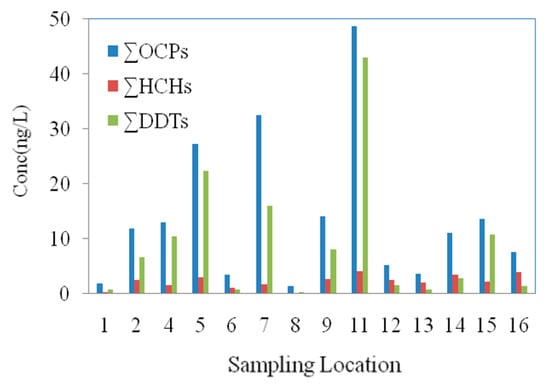
Figure 2.
The distributions of OCPs in the surface water sources in HWP.
HCHs and DDTs were two typical main pollutants among all these OCPs. Each HCH isomer was detected 100 percent of the time in the sediment, which may be a sign of the primary OCPs used in agriculture in the research area. The trend of HCHs concentration for several sediment sample sites is shown in Figure 3. The Longfengshan Reservoir in particular had greater HCH concentrations in the LWP than in the HWP. The results indicated that the increased water volume in the HWP can affect the amount of HCHs in the sediments, but water should also have a role in the decrease in HCHs concentrations in the sediments in the HWP. Solubility and persistence have an impact on OCP dispersion and fate after they reach the water system. Many OCPs will be adsorbed to particles in the water system, settle on the surface, and then eventually sink into the sediments. For several years until the sediments are remobilized, they can be kept in sediments without returning to the ocean.
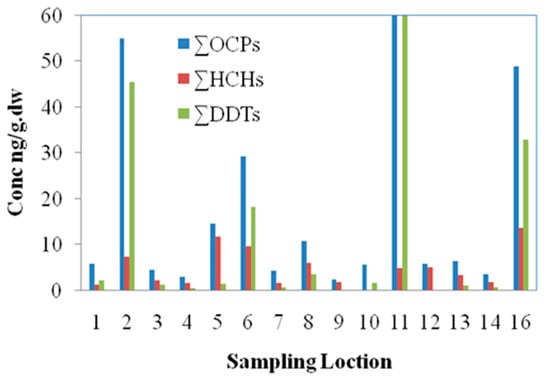
Figure 3.
The distributions of OCPs in sediment in HWP.
In contrast to sand, water has a distinct distribution of HCH concentrations. OCPs are often adsorbed to sediment particles in surface water and sediments, and they can then move from the sediments to the water by being resuspended [16,17]. The water and sediments of all the sampling stations have relevance to the concentration distribution. The law might encourage the release of a significant amount of HCHs from sediments to the overlying water, leading to secondary contamination, even though it is not so visible due to water disturbance and the parameters of major variations in the wet season.
Due to their extensive usage history, HCHs were discovered more frequently as the primary OCP pollutants in water. The detection frequencies of some target compounds, such as OCPs in the water, are quite high in both the HWP and LWP. The research demonstrates that of the three HCH isomers (α-HCH, β-HCH, and γ-HCH) in the water, β-HCH had the largest concentration, making up 42.2% to 85.5% (mean 68.7%) of all HCHs. β-HCH is followed by α-HCH, which was 7.5% to 40.9% (mean 22%), and then γ-HCH of 4.2% to 20.2% (mean 9.3%). The three isomers’ various ratios are mostly a result of their various chemical characteristics. β-HCH has a very stable structure and good symmetry, which cause it to be the most difficult to degrade among the HCHs. In addition, α-HCH in the environment is degraded quickly, which is the same as γ-HCH isomers. Three isomers of the environmental degradation speed (α > γ > β), high octanol-water partition coefficient (Log kow = 3.78), and steam pressure (3.610–7 mmHg, 20 °C) indicate that β-HCH is more easily combined with organic materials in sediment and less likely to move with the water flow or volatilize into the atmosphere. Additionally, to reach the most stable state, the other two isomers in water easily converted into β-HCH. As a result, β-HCH takes over as the main component in the water system.
The ratios of β-HCH were high in both the summer and winter, even though the compositions of HCHs isomers vary across different water systems. It demonstrated that the compositions of HCHs were mostly unaffected by the season. Understanding the pollutant source can be aided by knowing the stable composition. A variety of isomers, including α-HCH(55~80%), β-HCH(5~14%), γ-HCH(8~15%), and δ-HCH(2~16%), make up industrial HCHs. However, only γ-HCH has insecticidal activity. The α/γ-HCH ratio, which ranges from 4 to 7, indicates the rate of degradation and whether any new sources of pollution have been introduced into the ecosystem. A common broad-spectrum insecticide used in both agriculture and non-agriculture since the 1950s is lindane, which has a ratio of γ-HCH of 99% and a value of α/γ-HCH that is almost 0. Many affluent nations restrict the use of industrial lindane, while many other nations and regions still use it extensively. To determine the source of HCHs, the α/γ-HCH value is typically utilized [18,19]. The ratio of HCHs isomers in both the water and sediment at each sampling site throughout the wet season is displayed in Table 2. From 1.07 and 6.78, there is a mean value of 2.60. In contrast, the values measured at the other sampling sites are all less than four, indicating that the sources of the waters are not only the usage of HCH in the past but also the recent emission of the insecticide lindane. The values measured at sampling sites 4 and 5 exceed 4, and the α/γ ratio of the 2 isomers of HCH range from 1.14 to 7.24 (mean 3.47) in the sediments. The outcome is in line with the state-of-the-art optical situation in which nearby farmers continue to use the restricted insecticide lindane.

Table 2.
The ratio of HCHs in the surface water and sediments in HWP.
4.2. CUPs
Figure 4 makes it abundantly obvious that only site 2 in the LWP had a relatively high concentration of OPPs. Despite OPPs having a very brief half-life, the high usage left a significant amount of residue in the LWP.
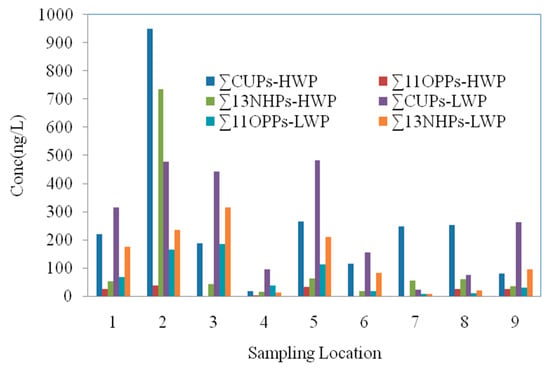
Figure 4.
The currently used pesticides distribution in the surface water.
A common type of pesticide is an herbicide, which stunts the growth of other plants by impeding their metabolism or photosynthesis or by damaging their cells or proteases. In the well-known rice-planting region of Wuchang, numerous herbicides have been or are now being utilized. Among the 13 different types of neutral herbicide pesticides (NHPs), only trifluralin, triallate, sensorial, benthiocarb, and isoprothiolane were not found in the surface water in the HWP. Diclofop-methyl has the highest detection frequency of 100%, followed by butachlor (55.5%). In the water in the HWP, the ∑NHPs ranged from 6.34 to 315 ng/dm3 (mean 127.0 ng/dm3). Similar to during the HWP, only triallate and sencoral were not found among the 13 different types of NHPs in the LWP; the ∑NHPs ranged in concentration from 15.6 to 736 ng/dm3 (mean 119 ng/dm3). The details are shown in Table 3.

Table 3.
The concentration of CUPs in the sediment and surface water.
Figure 5 makes it abundantly obvious that only site 7 in the HWP had a relatively high concentration of CUPs. Herbicides are dispersed in the same manner as OPPs. Because NHPs are easily broken down by nature, similar to OPPs, whether this type of pesticide may be identified or not depends on several factors, including usage close to sampling sites.
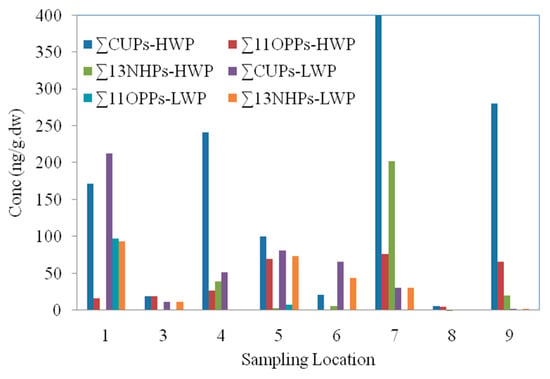
Figure 5.
The distribution of currently used pesticides (CUPs) in the sediment.
5. Conclusions
For all the surface water samples, the detection frequencies for p,p ‘-DDE, HCHs, and endosulfan sulfate were 100% and 75%, respectively. The ∑OCPs and ∑HCHs were, respectively, measured at 3.5–11.1 ng/dm3 (mean 6.5 ng/dm3) and 1.09–3.55 ng/dm3 (mean 3.01 ng/dm3). The ∑OCPs ranged from 0.42 to 7.78 ng/g dry wt. (mean 2.18 ng/g dry wt.) in the sediment. The Mopanshan Reservoir’s surface water and sediment have the lowest OCPs. OCPs contamination in the vicinity of the Mopanshan Reservoir is at a low level as compared to other watersheds in the country and abroad. The ratios of α-HCH/γ-HCH at sample sites 4 and 5 showed there is also recent insecticide lindane emission in the research area. This shows that pesticides are still being used close to the reservoir, which has impacted the reservoir’s water quality.
Disulfoton had the highest detection frequency in the surface water in the HWP (62.5%); methyl-paraoxon, methyl-parathion, and parathion were not found. The ∑OPPs were 0–184 ng/dm3 (mean 46.1 ng/dm3). Except for demeton, disulfoton, malathion, and chlorpyrifos, which had a very low detection frequency of 11.1~33.3% in the LWP, most of the 11 OPPs were not discovered. Only demeton, malathion, methyl paraoxon, rogor, and chlorpyrifos were found in the sediment samples in the LWP; the ∑OPPs ranged from the LoD to 96.9 ng/g dry wt. (mean 14.9 ng/g dry wt.). Except for chlorpyrifos-methyl, parathion-methyl, and parathion, 8 out of 11 OPPs were found in the HWP, and the ∑OPPs concentration range was from the LoD to 76. ng/g dry wt. (mean 30.7 ng/g dry wt.).
The only 13 NHs that were not discovered in the HWP in the surface water were trifluralin, triallate, sencoral, benthiocarb, and isoprothiolane. Diclofop-methyl had the greatest detection rate of 100%, followed by butachlor (55.5%), and the ∑NHs were 6.34~315 ng/dm3 (mean 127 ng/dm3). In the LWP, the NHs ranged from 15.6 to 736 ng/dm3 (mean 119 ng/dm3) and were only detected in the triallate and sencoral. The concentration of NHs in the sediment ranged from the LoD to 93.1 ng/g dry wt. (mean 28.3 ng/g dry wt.) in the LWP. The only NHs discovered in the HWP were acetochlor, alachlor, benthiocarb, machete, and isoprothiolane, with NHs ranging from the LoD to 203 ng/g dry wt. (mean 27.5 ng/g dry wt.).
These phenomena may be caused by the fact that the nearby villages engage in agricultural activity in the summer and use a lot of herbicides and other pesticides while using less of them in the winter. Another explanation could be that as the temperature rises, CUPs that freeze in the soil layer throughout the wintertime leak into the water body from the soil, increasing the concentration of CUPs there. A further study should be conducted to clarify the certain reasons and indicators and to stop the spread of the pollution before it is too late.
Endocrine disruptors were also found in the study area. In addition, atrazine des-isopropyl and des-ethyl had the highest concentrations in the sediment at 40.4 ng/g dry wt. and 13.9 ng/g dry wt., respectively. The greatest 2,4-D butylate concentrations were found in the silt at 274 ng/g dry wt. and the surface water at 16.2 ng/dm3.
Scholars have also been performing pertinent studies in recent years. According to their research, atmospheric long-range transport and dry wet deposition are to blame for the greater concentrations of OCPs and CUPs that were found in the sink region of the Northeast China Plain [20]. As a result, it is possible to view the Northeast China Plain as a distinctive region for the study of pesticide accumulation features across China. Their research can evaluate and examine the trajectory of pesticide accumulation using our data as a point of reference.
At present, it is necessary to combine water treatments with the current situation of the region and comprehensively consider the causes and transfer methods of the pollution. Then, we can attach great importance to the source and process and establish a more reasonable detection mechanism to reduce the pressure on the treatment end. Through consolidating the statistics, we could avoid the ineffectiveness and low performance of a single data point. With these methods, more difficulties would be solved regarding the safety of drinking water in villages and towns.
Author Contributions
Formal analysis, Y.Y.; data curation, Y.Y.; writing—original draft preparation, review and editing, Y.Y.; supervision, J.C. All authors have read and agreed to the published version of the manuscript.
Funding
This research was funded by Provincial funded project of Heilongjiang Provincial Finance Department (Grant No. CZKF2021C012), the National High Technology Research and Development Program of China (Grant No. 2007AA06Z339), and the Open Project of State Key Laboratory of Urban Water Resource and Environment, Harbin Institute of Technology (Grant No. QA201019).
Data Availability Statement
Not applicable.
Conflicts of Interest
The authors declare no conflict of interest.
References
- Fu, S.; Cheng, H.X.; Liu, Y.H.; Xu, X.B. Levels and distribution of organochlorine pesticides in various media in a mega-city, China. Chemosphere 2009, 75, 588–594. [Google Scholar] [CrossRef] [PubMed]
- Hu, W.Y.; Lu, Y.L.; Wang, G.; Wang, T.Y.; Luo, W.; Shi, Y.J.; Zhang, X.; Jiao, W.T. Organochlorine Pesticides in Soils Around Watersheds of Beijing Reservoirs: A Case Study in Guanting and Miyun Reservoirs. Bull. Environ. Contam. Toxicol. 2009, 82, 694–700. [Google Scholar] [CrossRef] [PubMed]
- Kim, K.S.; Lee, S.C.; Kim, K.H.; Shim, W.J.; Hong, S.H.; Choi, K.H.; Yoon, J.H.; Kim, J.G. Survey on organochlorine pesticides, PCDD/Fs, dioxin-like PCBs, and HCB in sediments from the Han river, Korea. Chemosphere 2009, 75, 580–587. [Google Scholar] [CrossRef]
- Zhang, P.; Song, J.M.; Yuan, H.M. Persistent organic pollutant residues in the sediments and mollusks from the Bohai Sea coastal areas, North China: An overview. Environ. Int. 2009, 35, 632–646. [Google Scholar] [CrossRef] [PubMed]
- Iturburu, F.G.; Calderon, G.; Amé, M.V.; Menone, M.L. Ecological Risk Assessment (ERA) of pesticides from freshwater ecosystems in the Pampas region of Argentina: Legacy and current use chemicals contribution. Sci. Total Environ. 2019, 691, 476–482. [Google Scholar] [CrossRef] [PubMed]
- Cortes, S.; Pozo, K.; Llanos, Y.; Martinez, N.; Foerster, C.; Leiva, C.; Ustáriz, J.; Přibylová, P.; Klánová, J.; Jorquera, H. First measurement of human exposure to current use pesticides (CUPs) in the atmosphere of central Chile: The case study of Mauco cohort. Atmos. Pollut. Res. 2020, 11, 776–784. [Google Scholar] [CrossRef]
- Li, H.; Sun, B.; Lydy, M.J.; You, J. Sediment-associated pesticides in an urban stream in Guangzhou, China: Implication of a shift in pesticide use patterns. Environ. Toxicol. Chem. 2013, 32, 1040–1047. [Google Scholar] [CrossRef] [PubMed]
- Matthies, M.; Klasmeier, J.; Beyer, A.; Ehling, C. Assessing Persistence and Long-Range Transport Potential of Current-Use Pesticides. Environ. Sci. Technol. 2009, 43, 9223–9229. [Google Scholar] [CrossRef] [PubMed]
- Ruggirello, R.M.; Hermanson, M.H.; Isaksson, E.; Teixeira, C.; Forsstrom, S.; Muir, D.C.G.; Pohjola, V.; van de Wal, R.; Meijer, H.A.J. Current use and legacy pesticide deposition to ice caps on Svalbard, Norway. J. Geophys. Res.-Atmos. 2010, 115, D18308. [Google Scholar] [CrossRef]
- De Wit, C.A.; Muir, D. Levels and trends of new contaminants, temporal trends of legacy contaminants and effects of contaminants in the Arctic: Preface. Sci. Total Environ. 2010, 408, 2852–2853. [Google Scholar] [CrossRef] [PubMed]
- Athanasopoulos, P.; Kyriakidis, N.B.; Georgitsanakou, I. Effect of storage temperature on the degradation of dimethoate in fortified orange and peach juices. J. Agric. Food Chem. 2000, 48, 4896–4899. [Google Scholar] [CrossRef] [PubMed]
- Mast, M.A.; Foreman, W.T.; Skaates, S.V. Current-use pesticides and organochlorine compounds in precipitation and lake sediment from two high-elevation national parks in the Western United States. Arch. Environ. Contam. Toxicol. 2007, 52, 294–305. [Google Scholar] [CrossRef] [PubMed]
- Ma, W.L.; Li, Y.F.; Qi, H.; Sun, D.Z.; Cheng, X. ORGN 473-Polycyclic aromatic hydrocarbons and polychlorinated biphenyls in topsoils of Harbin, China. Abstr. Pap. Am. Chem. Soc. 2008, 235, 1053. [Google Scholar]
- Ma, W.L.; Li, Y.F.; Sun, D.Z.; Qi, H. Polycyclic Aromatic Hydrocarbons and Polychlorinated Biphenyls in Topsoils of Harbin, China. Arch. Environ. Contam. Toxicol. 2009, 57, 670–678. [Google Scholar] [CrossRef] [PubMed]
- Ren, N.Q.; Que, M.X.; Li, Y.F.; Liu, Y.F.; Wan, X.N.; Xu, D.D.; Sverko, E.; Ma, J. Polychlorinated biphenyls in Chinese surface soils. Environ. Sci. Technol. 2007, 41, 3871–3876. [Google Scholar] [CrossRef] [PubMed]
- Zhang, Z.L.; Hong, H.S.; Zhou, J.L.; Huang, J.; Yu, G. Fate and assessment of persistent organic pollutants in water and sediment from Minjiang River Estuary, Southeast China. Chemosphere 2003, 52, 1423–1430. [Google Scholar] [CrossRef] [PubMed]
- Zhang, H.; Chai, Z.F.; Sun, H.B.; Zhang, J.L. A survey of extractable persistent organochlorine pollutants in Chinese commercial yogurt. J. Dairy Sci. 2006, 89, 1413–1419. [Google Scholar] [CrossRef] [PubMed]
- Moisey, J.; Fisk, A.T.; Hobson, K.A.; Norstrom, R.J. Hexachlorocyclohexane (HCH) isomers and chiral signatures of alpha-HCH in the arctic marine food web of the Northwater Polynya. Environ. Sci. Technol. 2001, 35, 1920–1927. [Google Scholar] [CrossRef] [PubMed]
- Wang, G.; Lu, Y.L.; Han, J.Y.; Luo, W.; Shi, Y.J.; Wang, T.Y.; Sun, Y.M. Hexachlorobenzene sources, levels, and human exposure in the environment of China. Environ. Int. 2010, 36, 122–130. [Google Scholar] [CrossRef] [PubMed]
- Wang, L.; Zhang, Z.F.; Liu, L.Y.; Zhu, F.J.; Ma, W.L. National-scale monitoring of historic used organochlorine pesticides (OCPs) and current used pesticides (CUPs) in Chinese surface soil: Old topic and new story. J. Hazard. Mater. 2023, 443 Pt B, 130285. [Google Scholar] [CrossRef]
Disclaimer/Publisher’s Note: The statements, opinions and data contained in all publications are solely those of the individual author(s) and contributor(s) and not of MDPI and/or the editor(s). MDPI and/or the editor(s) disclaim responsibility for any injury to people or property resulting from any ideas, methods, instructions or products referred to in the content. |
© 2023 by the authors. Licensee MDPI, Basel, Switzerland. This article is an open access article distributed under the terms and conditions of the Creative Commons Attribution (CC BY) license (https://creativecommons.org/licenses/by/4.0/).